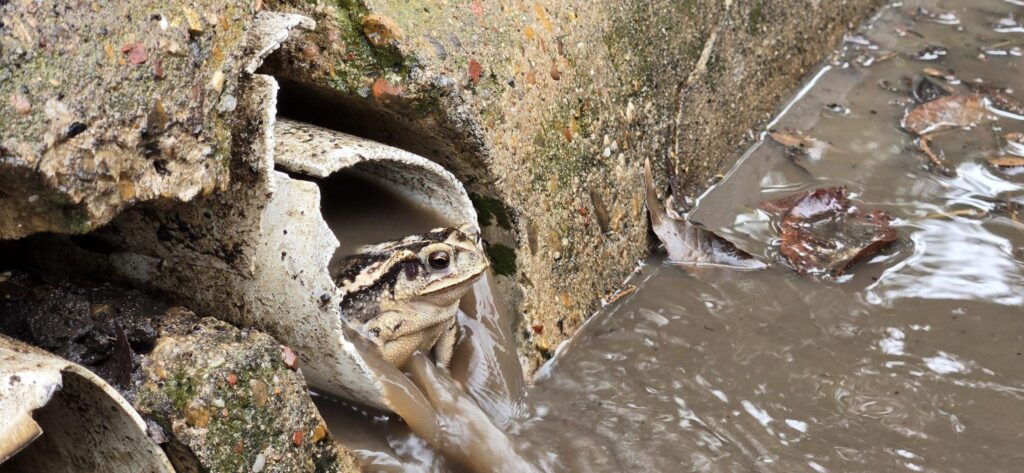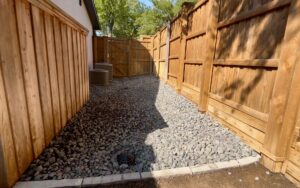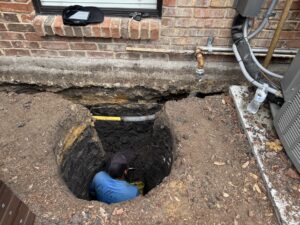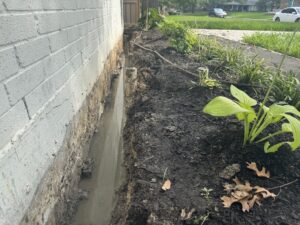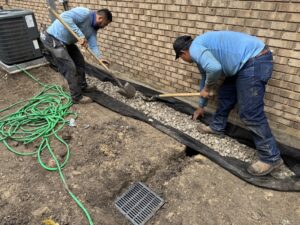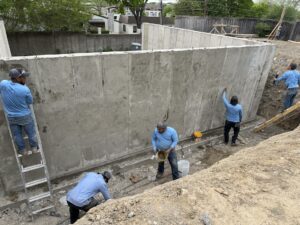The cost to install a drainage system, whether that be a standard yard drain or a more complex french drain system, can be pretty high. Even at the low end, a basic system generally starts at around $3,000 – and this is for a small property. It gets more expensive from there, especially if you need something more involved like a french drain, your yard is big, or you have no slope and need to install a sump pump. For a comprehensive and proactive drainage solution that addresses both surface and subsurface water issues, we see systems regularly run up to $10,000 and sometimes even more. However, expensive as that may be, this is not the complete picture of what it can cost to fix a drainage problem – let’s take a look…
When you have poor drainage at your house, there’s a myriad of problems that can occur. Poor drainage affects your home’s foundation, and if the foundation is off, you can soon find that a lot of other things are too. Hydrostatic pressure caused by standing water and saturated soil can cause a foundation to heave and sink, going up and down with the changing seasons. When this happens, you see things like cracks in the drywall, damage to flooring and separation between mortar joints. While these are unattractive and can be expensive to repair, there are worse (and far more costly) things that can happen, such as separation of a sewer line. When a house lifts or heaves, it will take the plumbing with it, potentially causing a break in one or more of the lines, such as the main sewer drain. Repairing this can be excruciating, easily costing $10,000, $20,000 or more… Of course, without the drainage issues fixed, this same problem could happen again, putting you back in the position of needing to make further repairs. We haven’t even mentioned fixing the foundation itself. Foundation repair work can quickly run upwards of $10,000 as well, leaving your total potential out of pocket expense in the tens of thousands of dollars…
While less costly financially, the aesthetic problems caused by improper drainage are an issue as well. It can be frustrating and concerning to feel unevenness when you walk across the floor or to see cracks appear in the sheetrock. Imagine working to create a beautiful living space, only to have a gaping eight foot crack looming over your seating area. Besides the actual expense of repairing this every year, the headache of dealing with that has its own cost as well. Improper drainage can also effect your outdoor spaces. How about the side yard that’s always muddy and is basically unusable? While this soggy yard is probably the source of your foundation woes, it is most certainly a frustration of its own. Having to avoid parts of your yard all the time is an annoyance and a waste, but it doesn’t have to be this way. By dealing with the poor drainage, you can not only prevent damage to the home, you can also take back your yard to enjoy and use.
When it comes to home ownership, the key to fewer headaches and reducing costs is to be proactive. Having proper drainage at your property to address the problem areas is the way to do this. You don’t necessarily need drainage everywhere – quite often it is one side of the house that is the issue. Grade and slope play crucial roles in determining where the water flows, and if your home is in the path of that flow, it becomes the problem. What a proper drainage system does is divert the water around your home, so it doesn’t have a chance to work against things like the foundation. Remember, water is very powerful (think Grand Canyon) and will work against standing structures if not managed correctly.
So when it comes to the true cost of drainage, consider all the other parts of a home that improper drainage can negatively impact: cosmetic features such as drywall, critical functions such as plumbing, and structural components like the foundation (not to mention the emotional toll of the frustration that comes with any of these things failing.) From a big picture perspective, the cost of not fixing bad drainage will likely be more than fixing it correctly in the beginning. The important thing here is that the drainage is addressed correctly. We dig up a lot of old drainage during the course of our projects, and often find the existing system to have been installed incorrectly. It is a nuanced field that requires a certain understanding of the physical property of water – how it behaves both above and below ground. You’d be surprised by the bizarre things we see buried underground – things that are constructed with drainage components, but that don’t actually drain anything. So this would be the final piece of advice – if you’re going to be the most cost-conscious you can be, don’t just address the drainage first, address it correctly, so you don’t have to come back and do it again.
Proper drainage is a critical factor in maintaining a healthy foundation for buildings and structures. While it might not be the first thing that comes to mind when thinking about construction and home maintenance, the significance of effective drainage cannot be overstated. In this article, we will explore why proper drainage is important for a healthy foundation and how it plays a crucial role in preventing potential damage.
- Prevention of Soil Erosion:
One of the primary reasons for ensuring proper drainage is to prevent soil erosion around the foundation. When water accumulates near the base of a structure, it can lead to the erosion of soil. Over time, this erosion weakens the foundation’s support, making it susceptible to cracks and shifts. Implementing proper drainage systems helps control the flow of water away from the foundation, preserving the integrity of the soil.
- Avoiding Foundation Settlement:
Inadequate drainage can contribute to foundation settlement, where the structure sinks into the ground unevenly. When soil becomes oversaturated with water, it loses its ability to provide stable support. This can result in uneven settling, causing cracks in walls, floors, and other structural damage. Proper drainage helps maintain soil stability and prevents the risk of foundation settlement.
- Preventing Basement Flooding:
Improper drainage is a common cause of basement flooding. When rainwater or melted snow is not directed away from the foundation, it can seep into the basement, causing water damage and potential mold growth. Installing a reliable drainage system, such as gutters and downspouts, ensures that water is efficiently channeled away from the foundation, reducing the risk of basement flooding.
- Minimizing Hydrostatic Pressure:
Hydrostatic pressure occurs when water accumulates around the foundation and exerts force against the walls. This pressure can lead to cracks, leaks, and structural damage. Proper drainage systems, including effective grading and the use of French drains, help minimize hydrostatic pressure by redirecting water away from the foundation, safeguarding it against potential damage.
- Preserving Structural Integrity:
A healthy foundation is crucial for the overall structural integrity of a building. When a foundation is compromised, it can affect the entire structure, leading to costly repairs and safety concerns. By prioritizing proper drainage, property owners can preserve the foundation’s health and extend the lifespan of the building.
In conclusion, proper drainage is a fundamental aspect of maintaining a healthy foundation. It addresses various issues, including soil erosion, foundation settlement, basement flooding, hydrostatic pressure, and overall structural integrity. Investing in effective drainage systems not only protects the foundation but also contributes to the longevity and stability of the entire structure. Whether through grading, gutters, or other drainage solutions, property owners should prioritize this aspect of construction and maintenance to ensure a solid foundation for their buildings.
Dealing with stagnant water in your yard due to heavy rain and inadequate grading is essential for avoiding potential flooding and water damage to your home. The installation of a French drain system is a practical remedy to redirect water away from your home, securing its foundation and creating a more enjoyable outdoor environment in general. In its essence, a French drain involves the excavation of a trench in problematic sections of the yard. This trench is subsequently filled with a water-permeable fabric, followed by a perforated pipe encased in and overlaid with stone or gravel. The operational efficiency of a French drain system hinges on gravity, guiding water down through the stones into the hollow pipe. This natural progression enables efficient water redirection toward any suitable drainage outlet, such as a creek, pond or city storm drain (aka a street or alley.)
The roots of the French drain trace back to 1859 when Henry French, a judge and farmer from Concord, Massachusetts, outlined the concept in his book. Initially crafted to drain excess water from crop fields, the system gained popularity for enhancing crop yield, diminishing yard saturation, and safeguarding housing foundations. The foundational design of a French drain harnesses scientific principles to eliminate surplus water from specific locations. Gravity assumes a pivotal role in drawing water into the soil, and the drain provides an optimal route for water through a hollow, perforated pipe beneath layers of stone or gravel.
In instances of heavy rainstorms, water pooling around a home’s foundation can result in flooding or basement seepage. The installation of a French drain surrounding the foundation efficiently diverts water into the hollow drainage pipe, leveraging water’s natural inclination to follow the path of least resistance. The fundamental principle of a French drain is to create this path of least resistance for water, preventing and standing water and hydrostatic pressure. This is accomplished through a hollow, perforated drainage pipe that gathers and conveys water from the yard to a designated drainage point. The trench is enveloped in water-permeable fabric to prevent dirt and other debris from obstructing perforations or from dirtying the surrounding gravel. The substitution of soil with stones or gravel facilitates water flow, as the larger gaps in packed stone provide a more effortless route than densely packed soil.
Each component of a French drain is meticulously designed to facilitate the flow of water from the surface, through stones, perforations, and into the hollow drainage pipe. The pipe’s angle ensures immediate water flow away from the home, preventing water accumulation and potential flooding. It is imperative to employ water-permeable fabric for wrapping the drainage rock; otherwise, the systems effectiveness in channeling water may be compromised, causing the french drain to fail prematurely.
Determining When to Opt for French Drain Systems:
There are many reasons why you might consider installing a French drain. If you are experiencing any of the following issues, a French drain might be the solution:
- Recurring Flooding and Foundation Damage: French drains act as protective measures against recurrent floods and prevent further damage to the foundation. A French drain helps to alleviate hydrostatic pressure around the foundation by offering an alternative water path, circumventing foundation wall cracks.
- Pooling Surface Water: French drains are effective in attracting water that accumulates in puddles or large pools on the surface. The drain draws water from saturated soil, providing a straightforward path for it to follow. The redirected water can be channeled to suitable drainage locations such as the street or alley (either directly or via a sump pump.)
- Retaining or Basement Walls Under Pressure: To shield retaining or basement walls from heightened pressure resulting from overly saturated soil during heavy rainfall, the installation of a French drain aids in drawing excess water and redirecting its flow away from the retaining wall, preserving the structure’s integrity.
Considering the Cost of French Drain Installation:
Before initiating the installation of a French drain, it is essential to account for material costs and potential expenses associated with professional installation. While proficient DIYers may undertake the task, many opt for professional installation to ensure efficacy and peace of mind. Professional installation often comes with warranties, addressing any issues with the French drain or potential damage to electrical or plumbing lines during installation. The average professional installation cost of a French drain varies, with factors like the depth of the drainage trench influencing material and especially labor costs. French drains typically incur costs starting at around $50 per linear foot, and can cost more depending on how deep you need it installed. In conclusion, a French drain system is a holistic solutions to tackle water-related challenges, creating an efficient route for water redirection, safeguarding homes, and amplifying the functionality of outdoor spaces.




